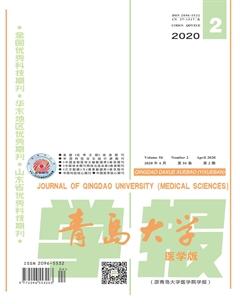载脂蛋白D对多巴胺能神经元的保护作用
戴莹莹 阎春玲 毕明霞 焦倩 杜希恂 姜宏

[摘要] 目的 探讨载脂蛋白D (Apo D)对多巴胺能神经元保护作用。方法 首先观察25~500 μmol/L的1-甲基-4-苯基吡啶阳离子(MPP+)对MES23.5细胞存活率的影响,确定最佳造模浓度;在此基础上观察2~32 nmol/L Apo D预处理对200 μmol/L的MPP+诱导的MES23.5细胞存活率的影响。结果 与MPP+处理组相比,8 nmol/L Apo D预处理可明显拮抗MPP+诱导的MES23.5细胞存活率的降低,差异有显著性(F=85.06,P<0.01)。结论 外源性Apo D可拮抗多巴胺能神经元损伤并发挥其保护作用,这为PD的防治提供新的思路。
[关键词] 帕金森病;载脂蛋白D类;多巴胺能神经元
[中图分类号] R742.5 [文献标志码] A [文章编号] 2096-5532(2020)02-0140-03
doi:10.11712/jms.2096-5532.2020.56.093 [开放科学(资源服务)标识码(OSID)]
[网络出版] http://kns.cnki.net/kcms/detail/37.1517.R.20200519.1433.005.html;2020-05-20 08:59
[ABSTRACT] Objective To investigate the protective effect of apolipoprotein D (Apo D) on dopaminergic neurons. Methods First, the effect of 25-500 μmol/L 1-methyl-4-phenylpyridiniumion (MPP+) on the survival rate of MES23.5 cells was observed to find the optimal modeling concentration. Then on this basis, the effect of 2-32 nmol/L Apo D pre-treatment on the survival rate of MES23.5 cells induced by 200 μmol/L MPP+ was observed. Results Compared with the MPP+ treatment group, 8 nmol/L Apo D pre-treatment could significantly antagonize MPP+-induced decrease in the survival rate of MES23.5 cells (F=85.06,P<0.01). Conclusion Exogenous Apo D can antagonize dopaminergic neuronal injury and exert a protective effect, which provides new ideas for the prevention and treatment of Parkinsons disease.
[KEY WORDS] Parkinson disease; apolipoproteins D; dopaminergic neurons
帕金森病(PD)是一種多发于中老年人中枢神经系统的退行性疾病,主要临床症状为静止性震颤、肌僵直、运动迟缓和姿势反射性障碍等[1-2]。PD的主要病理特征是中脑黑质(SN)多巴胺能神经元选择性缺失,残存的神经元内出现以α-突触核蛋白(α-Syn)异常聚集为主形成的路易小体(LBs)[3-4]。PD的病因尚未明确,与氧化应激、自由基形成、金属动态平衡和线粒体功能障碍相关的机制都有涉及[5]。最近的研究表明,PD转基因小鼠大脑胆固醇水平升高,而载脂蛋白参与胆固醇稳态的维持,载脂蛋白与PD之间可能存在联系[6-8]。载脂蛋白D(Apo D)是载脂蛋白家族的成员之一[9],在中枢神经系统中,Apo D主要由星形胶质细胞和少突胶质细胞产生和分泌,为在衰老的大脑、神经退行性疾病和精神疾病中始终过量表达的少数基因之一[10-11]。研究表明,转基因小鼠Apo D过表达导致其对氧化应激的抗性增强[12-15]。相反,小鼠、植物和果蝇中的Apo D失活导致氧化抗性降低,从而降低其存活率[13,16-19]。那么,Apo D对PD病理细胞模型是否具有保护作用呢?本研究探讨Apo D对多巴胺能神经元的作用,以期为PD的防治提供新的思路。
1 材料与方法
1.1 细胞培养
将MES23.5细胞在含有体积分数0.05的胎牛血清和100 kU/L青霉素和链霉素的DMEM-F12(Gibco,USA)培养液中培养。细胞以1×105/cm2的密度接种在平板中,生长到70%~80%融合度,将细胞分为4组。①对照组:与ddH2O预孵育48 h;②MPP+处理组:与ddH2O预孵育24 h,然后加入200 μmol/L MPP+孵育24 h;③Apo D处理组:与2~32 nmol/L Apo D(Biovendor,USA)共孵育48 h;④Apo D-MPP+组:与2~32 nmol/L ApoD预孵育24 h,然后与200 μmol/L MPP+孵育24 h。
1.2 细胞活力测定
应用3-(4,5-二甲基噻唑-2)-2,5-二苯基四氮唑溴盐(MTT)测定法测定细胞活力。各组细胞经处理后,将培养基换成最终浓度为5 g/L的MTT溶液,37 ℃条件下放置4 h。弃去培养基,向各孔加入100 μL DMSO,于摇床震荡10 min至晶体完全溶解,使用酶标仪(Molecular Device,USA)分别检测494 nm和630 nm波长处吸光度(A)值,计算各组细胞存活率。细胞存活率=实验组吸光度均值(A494-A630)/阴性对照组吸光度均值(A494-A630)×100%。
1.3 統计学方法
应用SPSS 17.0统计软件进行数据处理,符合正态分布的计量资料结果以±s表示。多组均数的比较采用单因素方差分析(One-way ANOVA),继以 Tukey方法进行两两均数间的比较。P<0.05表示差异有统计学意义。
2 结 果
2.1 不同浓度MPP+诱导的MES23.5细胞存活率比较
MES23.5细胞经25~500 μmol/L的MPP+预处理24 h后,MTT法检测细胞活力结果见表1。与对照组比较,25~500 μmol/L MPP+处理组细胞存活率降低(F=52.90,P<0.001),其中200 μmol/L处理组细胞的存活率降低了34.6%(P<0.001)。考虑到200 μmol/L MPP+是引起细胞损伤的最低浓度,因此选择将其用于后续实验。
2.2 Apo D处理对MPP+诱导的MES23.5细胞存活率降低的影响
使用2~32 nmol/L浓度范围的Apo D预处理24 h,可以拮抗MPP+诱导的细胞毒性(F=13.20,P<0.001),并在8 nmol/L发挥其最大的保护作用(P<0.01)。见表2。不同浓度的Apo D处理没有产生细胞毒性作用(F=4.06,P<0.001)。见表3。因此,Apo D预处理对MPP+处理的MES23.5细胞具有保护作用。
3 讨 论
有研究显示,Apo D在神经退行性疾病中上调,延长了寿命并增加了果蝇的抗逆性[14]。PD病人的SN中Apo D也增加[20],这意味着PD病人脑中Apo D与PD有关。Apo D可自由通过血-脑脊液屏障。有研究显示,2、4、8 nmol/L Apo D可拮抗PQ处理的原代星形胶质细胞存活率的降低[12]。那么,外源给予Apo D对多巴胺能神经元是否发挥保护作用呢?本研究结果显示,Apo D预孵育可以拮抗MPP+诱导的MES23.5细胞存活率的降低,说明Apo D对多巴胺能神经元具有保护作用;其保护作用与浓度有关,以8 nmol/L浓度保护作用最大。而单独给予不同浓度Apo D处理MES23.5细胞的存活率没有变化,说明外源性使用Apo D对细胞没有毒性作用。因此,推测临床使用Apo D应该是安全的,这为Apo D的临床应用提供了基础。
MPP+可以通过多巴胺再摄取系统进入细胞,并抑制线粒体呼吸链的复合体Ⅰ产生氧化应激,线粒体功能障碍和氧化应激引起的多巴胺能神经元变性是PD的重要特征[21]。研究表明,Apo D在转基因小鼠中的过度表达可使其对氧化应激的抗性增强[12]。由此我们推测, Apo D对多巴胺能神经元的保护作用可能与其抗氧化应激有关。
总之,Apo D对MPP+诱导的细胞毒性具有拮抗作用,从而保护多巴胺能神经元免受氧化应激的损伤,Apo D可能对PD的治疗具有临床意义。
[参考文献]
[1] ELKOUZI A. VEDAM-MAI V, EISINGER R S. Emerging therapies in Parkinson disease-repurposed drugs and new approaches[J]. Natural Review Neurology, 2019,15(4):204-223.
[2] OPARA J, MALECKI A, MALECKA E, et al. Motor assessment in Parkinsons disease[J]. Annals of Agricultural and Environmental Medicine: AAEM, 2017,24(3):411-415.
[3] CHEN Bingbing, WEN Xiaoming, JIANG Hong, et al. Inte-ractions between iron and alpha-synuclein pathology in Parkinsons disease [J]. Free Radical biology and Medicine, 2019,141:253-260.
[4] FU H J, HARDY J, DUFF K. Selective vulnerability in neurodegenerative diseases [J]. Nature neuroscience, 2018,21(10):1350-1358.
[5] SHEIKH S, SAFIA, HAQUE E, et al. Neurodegenerative diseases: multifactorial conformational diseases and their the-rapeutic interventions [J]. Journal of Neurodegenerative Diseases, 2013, 2013:563481.
[6] VARKEY J, ISAS J M, MIZUNO N, et al. Membrane curvature induction and tubulation are common features of synuc-leins and apolipoproteins[J]. Journal of Biological Chemistry, 2010,285(42):32486-32493.
[7] EMAMZADEH F N. Role of apolipoproteins and alpha-Synuclein in Parkinsons disease[J]. Journal of Molecular Neuroscience, 2017,62(3/4):344-355.
[8] KOOB A O, UBHI K, PAULSSON J F, et al. Lovastatin ameliorates alpha-synuclein accumulation and oxidation in transgenic mouse models of alpha-synucleinopathies[J]. Experimental Neurology, 2010,221(2):267-274.
[9] RASSART E, BEDIRIAN A, DO CARMO S, et al. Apolipoprotein D[J]. Biochimica et Biophysica Acta, 2000,1482(1/2):185-198.
[10] DASSATI S, WALDNER A, SCHWEIGREITER R. Apolipoprotein D takes center stage in the stress response of the aging and degenerative brain[J]. Neurobiology of Aging, 2014,35(7):1632-1642.
[11] MANGANO E N, HAYLEY S. Inflammatory priming of the substantia nigra influences the impact of later paraquat exposure: neuroimmune sensitization of neurodegeneration[J]. Neurobiology of Aging, 2009,30(9):1361-1378.
[12] BAJO-GRANERAS R, GANFORNINA M D, MARTINTEJEDOR E, et al. Apolipoprotein D mediates autocrine protection of astrocytes and controls their reactivity level, contributing to the functional maintenance of Paraquat-Challenged dopaminergic systems[J]. Glia, 2011,59(10):1551-1566.
[13] CHARRON J B, OUELLET F, HOUDE M, et al. The plant apolipoprotein D ortholog protects arabidopsis against oxidative stress [J]. BMC Plant Biology, 2008,8:86.
[14] MUFFAT J. WALKER D W, BENZER S. Human Apo D, an apolipoprotein up-regulated in neurodegenerative diseases, extends lifespan and increases stress resistance in drosophila[J]. Proceedings of the National Academy of Sciences of the United States of America, 2008,105(19):7088-7093.
[15] DO CARMO S, JACOMY H, TALBOT P J, et al. Neuroprotective effect of apolipoprotein D against human coronavirus OC43-induced encephalitis in mice[J]. Journal of Neuroscience, 2008,28(41):10330-10338.
[16] GANFORNINA M D, DO CARMO S, MARTINEZ E, et al. Apo D, a Glia-Derived apolipoprotein, is required for periphe-ral nerve functional integrity and a timely response to injury[J]. Glia, 2010,58(11):1320-1334.
[17] GANFORNINA M D, DO CARMO S, LORA J M, et al. Apolipoprotein D is involved in the mechanisms regulating protection from oxidative stress[J]. Aging Cell, 2008,7(4):506-515.
[18] SANCHEZ D, LOPEZ A, TORROJA L, et al. Loss of glial lazarillo, a homolog of apolipoprotein D,reduces lifespan and stress resistance in drosophila[J]. Current Biology: CB, 2006,16(7):680-686.
[19] GLASS C K, SAIJO K, WINNER B, et al. Mechanisms underlying inflammation in neurodegeneration[J]. Cell, 2010,140(6):918-934.
[20] ORDONEZ C, NAVARRO A, PEREZ C, et al. Apolipoprotein D expression in substantia nigra of Parkinson disease[J]. Histology and Histopathology, 2006,21(4):361-366.
[21] SHEN Xiaoli, SONG Ning, DU Xixun, et al. Nesfatin-1 protects dopaminergic neurons against MPP(+)/MPTP-induced neurotoxicity through the C-Raf-ERK1/2-dependent anti-apoptotic pathway [J]. Scientific Reports, 2017,7:40961.
(本文編辑 黄建乡)

